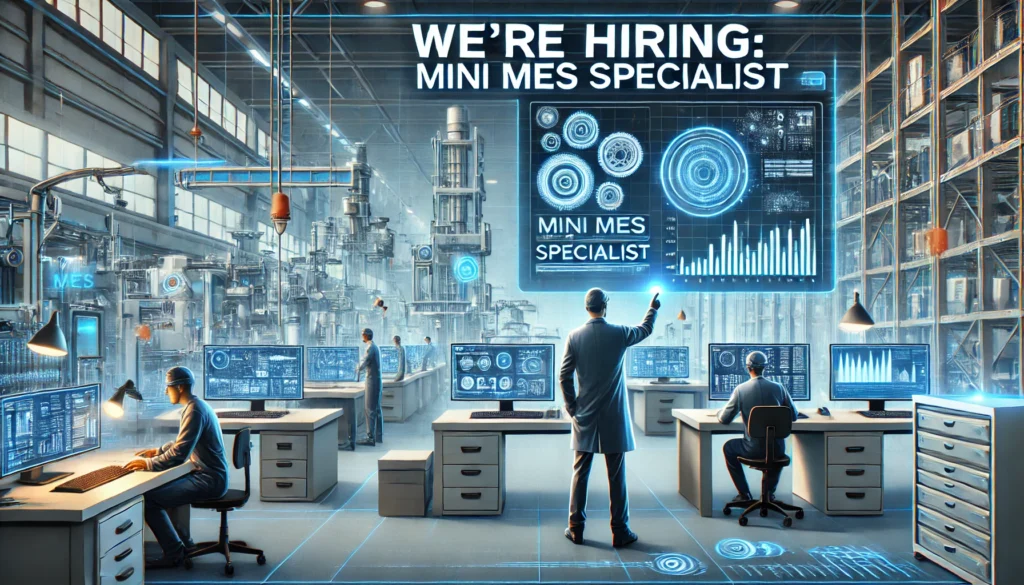Discover how to set up a Manufacturing Execution System to streamline production, improve efficiency, and reduce costs. Learn key benefits, setup steps, and expert tips!
A Manufacturing Execution System is a lightweight version of a traditional MES, designed for small and medium-sized enterprises (SMEs). It helps businesses track, monitor, and optimize production processes without the complexity or high costs of a full-scale MES.

Basic Information About Mini MES
| Feature | Description |
|---|---|
| Purpose | Streamlines production monitoring and control |
| Ideal For | Small & medium-sized manufacturers |
| Main Functions | Track production, monitor performance, reduce waste |
| Benefits | Lower costs, improved efficiency, better quality control |
| Implementation Time | Few weeks to a few months |
| Cost | More affordable than full MES solutions |
Why Choose a Mini MES?
A Mini MES provides real-time insights into manufacturing operations, allowing businesses to:
✅ Improve efficiency – Reduce downtime and increase productivity.
✅ Enhance quality control – Detect errors early and ensure consistent quality.
✅ Optimize resource usage – Reduce material waste and improve cost management.
✅ Increase visibility – Get a clear overview of production processes.
Unlike full-scale MES, a Manufacturing Execution System is budget-friendly and easier to implement, making it perfect for SMEs.
How to Implement a Manufacturing Execution System in Your Business
1. Identify Your Needs
Before setting up a Mini MES, define your goals:
- Do you want to track production?
- Are you aiming to reduce material waste?
- Do you need better workforce management?
2. Choose the Right Mini MES Software
Look for features like:
- Real-time production tracking
- Inventory management
- Integration with existing ERP systems
- User-friendly dashboards & reports
3. Plan the Implementation
Create a step-by-step roadmap for rolling out the system:
- Assign a team to oversee the implementation.
- Set a timeline for integration.
- Train employees to use the new system.
4. Integrate with Existing Systems
For seamless operation, your Mini MES should connect with:
- ERP systems
- IoT devices & sensors
- Production machines
5. Monitor & Optimize
Once your Mini MES is up and running:
✔ Track performance using real-time data.
✔ Identify bottlenecks and areas for improvement.
✔ Continuously update and optimize processes.
Common Challenges & Solutions
| Challenge | Solution |
|---|---|
| Lack of technical knowledge | Choose a user-friendly MES with strong customer support. |
| Integration issues | Opt for software compatible with existing systems. |
| Employee resistance | Provide training and highlight benefits. |
| Budget constraints | Start with a basic Mini MES and upgrade as needed. |
Mini MES vs. Full MES – What’s the Difference?
| Feature | Mini MES | Full MES |
|---|---|---|
| Cost | Affordable | Expensive |
| Implementation Time | Faster | Longer |
| Best for | SMEs | Large enterprises |
| Customization | Limited | Extensive |
| Integration Complexity | Low to Medium | High |
A Mini MES is a great starting point for businesses that want the benefits of MES without the high cost and complexity.
Success Stories
Many small manufacturers have successfully implemented Mini MES solutions to:
✔ Increase production efficiency by 30%
✔ Reduce material waste by 20%
✔ Improve quality control processes
By leveraging real-time insights, businesses can make data-driven decisions and scale operations efficiently.
Get Started
Are you ready to streamline your production process with a Manufacturing Execution System? Contact us for expert advice and find the best solution for your business!
📞 Contact Information:
| Support Team | Contact Details |
|---|---|
| support@minimesolutions.com | |
| ☎ Phone | +1 234-567-890 |
| 🌐 Website | www.minimesolutions.com |
| 📍 Address | 123 Industry Street, New York, NY |
Cleck For The More Information: https://smartscholarshipshub.com
Frequently Asked Questions (FAQs)
What is a Mini MES, and how does it work?
A Manufacturing Execution System is a lightweight version of a traditional MES. It helps small and medium-sized manufacturers track production, monitor efficiency, and optimize processes in real time. It collects data from machines and workers, providing insights to improve productivity and reduce waste.
How is a Manufacturing Execution System different from a full MES?
✅ More affordable – Lower implementation costs.
✅ Simpler to use – Designed for SMEs with fewer technical resources.
✅ Faster to implement – Can be set up in weeks, not months.
✅ Less complex – Focuses on core manufacturing needs without unnecessary features.
What industries can benefit from a MES?
Solutions are ideal for industries such as:
Automotive (small parts manufacturers)
Food & beverage (batch processing & tracking)
Electronics (component assembly)
Textile & apparel (production monitoring)
Pharmaceuticals (compliance & tracking)
Can a Mini MES integrate with my existing ERP system?
Yes! Most Mini MES solutions offer integration options with ERP software, IoT devices, and production machines. Always check if the system you choose is compatible with your existing tools.
Do I need an IT team to manage a Mini MES?
No, a Mini MES is designed to be user-friendly. Many systems come with cloud-based support, automatic updates, and simple dashboards that require little to no IT expertise.
How long does it take to implement a Mini MES?
The implementation time depends on:
The size of your business
The complexity of your production processes
The software you choose
You can be implemented within a few weeks if properly planned.
How much does a Mini MES cost?
Costs vary based on features and vendor pricing. However, Mini MES solutions are significantly cheaper than full MES systems, making them a cost-effective option for SMEs.
What are the key features to look for in a Mini MES?
When selecting time look for:
✔ Real-time production tracking
✔ Inventory & materials management
✔ Quality control monitoring
✔ Performance analytics & reporting
✔ Cloud or on-premise options
How do I get started with a Mini MES?
To get started:
1️⃣ Identify your business needs.
2️⃣ Choose a smal MES that fits your production processes.
3️⃣ Plan the implementation with your team.
4️⃣ Train employees on how to use it.
5️⃣ Monitor and optimize your system over time.

